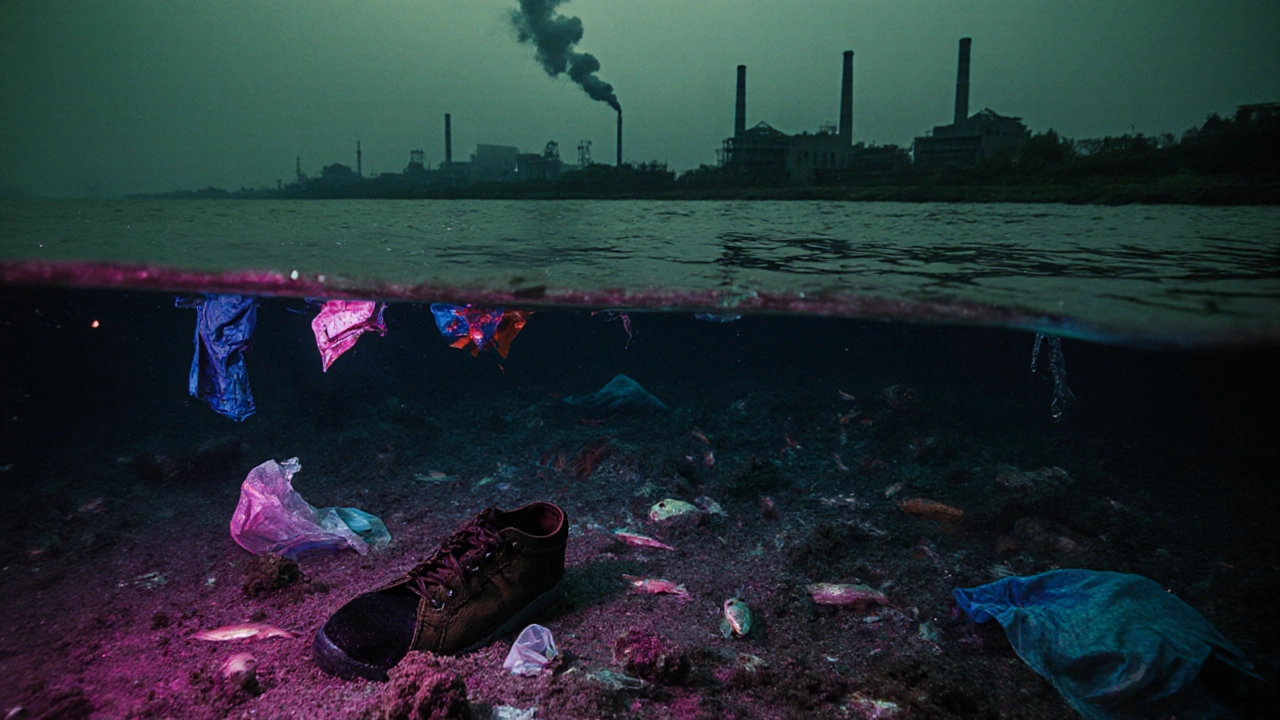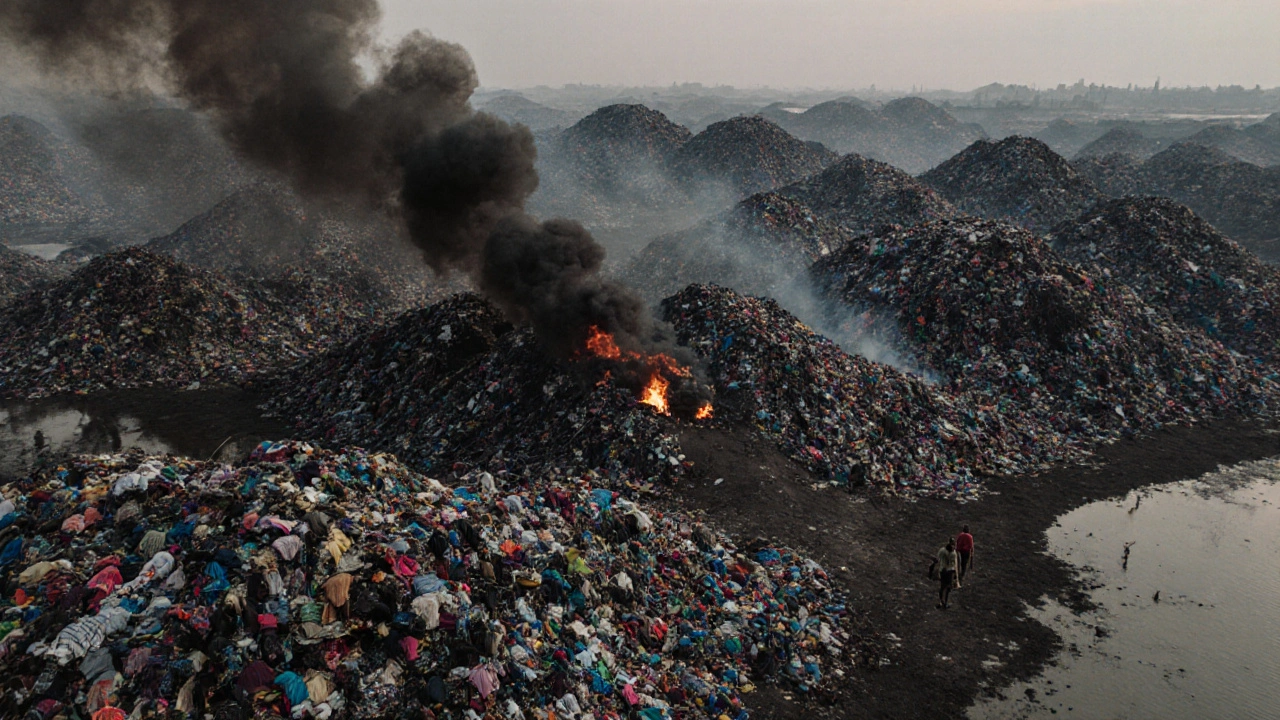Fast fashion doesn’t just drain your wallet-it’s draining the planet. Every year, the fashion industry uses 2,700 liters of water to make a single cotton t-shirt. That’s enough drinking water for one person for 2.5 years. And that’s just one shirt. Behind the $10 blouse you bought on sale last week is a trail of polluted rivers, toxic dyes, and mountains of discarded clothes that will outlive your grandchildren.
How Much Water Does Fast Fashion Really Use?
The fashion industry is the second-largest consumer of water on Earth, after agriculture. Cotton, the most common fabric in fast fashion, is a thirsty crop. It takes about 2,700 liters of water to grow the cotton for one t-shirt. In countries like India and Pakistan, where most of the world’s cotton is grown, farmers are pumping groundwater faster than rain can refill it. In some regions, wells have run dry. Entire villages now rely on water trucks.
But it’s not just growing cotton. The dyeing and finishing process uses even more. Textile dyeing is responsible for 20% of global wastewater. In Bangladesh, where over 4,000 garment factories operate, untreated wastewater flows straight into rivers like the Buriganga. Fish die. Crops fail. Children get sick from bathing in water stained with synthetic dyes.
Brands claim they’re switching to "eco-friendly" cotton. But organic cotton still needs water-just less pesticides. And most fast fashion doesn’t use organic cotton at all. It uses cheap, chemically treated cotton grown in monocultures that destroy soil and require massive irrigation. Water waste isn’t a side effect of fast fashion-it’s built into the business model.
The Toxic Soup Behind Your Clothes
Every piece of clothing you buy has been treated with chemicals. Dyes, finishes, flame retardants, waterproofing agents, and wrinkle-resistant coatings all contain toxic substances. Many of these are banned in the U.S. and EU-but not in the countries where clothes are made.
One of the most common offenders is perfluorinated chemicals (PFCs), used to make fabrics water- and stain-resistant. These don’t break down. They stick to your skin, enter your bloodstream, and show up in your blood tests years later. In 2023, Greenpeace tested 150 fast fashion brands. Over 70% still used hazardous chemicals in their supply chains. Even "green" labels like "PETA-approved vegan" or "recycled polyester" don’t guarantee safe chemicals.
Wastewater from dye factories in China, Vietnam, and Turkey often contains heavy metals like lead, mercury, and cadmium. These don’t disappear. They settle in riverbeds, get absorbed by rice paddies, and end up in your food. A 2024 study from the University of Tokyo found detectable levels of textile chemicals in 89% of fish caught near major garment manufacturing zones.
And here’s the kicker: you wash these clothes. Every time you throw a synthetic shirt in the washer, you release thousands of microplastics into the water system. A single load can shed 700,000 plastic fibers. They end up in oceans, in seafood, even in the salt on your table.

Textile Waste: The Invisible Mountain
Every second, the equivalent of one garbage truck of clothing is burned or dumped. That’s 92 million tons of textile waste per year. Less than 1% of that is recycled into new clothing. The rest ends up in landfills or is shipped to poorer countries.
In Ghana, the world’s largest secondhand clothing market is in Accra’s Kantamanto Market. Over 40% of the 15 million garments arriving each week are too damaged to sell. They pile up in alleys, burn in open fires, or wash into lagoons during the rainy season. Locals call it "the graveyard of fashion." The smell is unbearable. The soil is poisoned.
Even "recycled" polyester isn’t a solution. It’s still plastic. It sheds microfibers. It can only be recycled a few times before it degrades. And most recycling programs are greenwashing. Brands say they take back old clothes-but only to sell them as rags or insulation, not to make new shirts. The Ellen MacArthur Foundation found that only 0.1% of clothing fiber is reused to make new garments.
Fast fashion’s model depends on you buying more, wearing less, and throwing out faster. The average American buys 68 pieces of clothing a year and wears each item just seven times. That’s not fashion. That’s waste.

What You Can Actually Do
Stopping fast fashion isn’t about buying fewer clothes-it’s about changing how you think about them.
- Buy less, choose well. Instead of five $15 shirts, buy one $75 shirt made by a brand that publishes its factory locations and chemical use. Look for certifications like GOTS (Global Organic Textile Standard) or Fair Trade Certified.
- Wash less, wash cold. Every time you wash synthetic clothes, you release microplastics. Air dry when you can. Use a Guppyfriend bag to catch fibers in the wash.
- Repair, don’t replace. Learn basic sewing. Mend a seam. Replace a button. A $5 repair can extend a garment’s life by years.
- Support brands that are transparent. Patagonia, Eileen Fisher, and Pact publish their supply chains. They use natural dyes, recycled materials, and closed-loop water systems. They’re not perfect-but they’re trying.
- Don’t donate to charities if you don’t know where it goes. Many "donations" end up in landfills abroad. Instead, sell, swap, or give directly to local thrift stores that know their supply chains.
It’s not about being perfect. It’s about being intentional. One person can’t fix the system. But 10,000 people refusing to buy a $5 shirt? That changes the math.
Why This Matters More Than You Think
Fast fashion isn’t just an environmental issue-it’s a human rights issue. The same factories that pollute rivers pay workers $2 a day. The same chemical runoff that kills fish also causes miscarriages and cancer in nearby communities. The same waste choking landfills in Ghana was made by workers who can’t afford to buy new clothes themselves.
When you buy a $10 dress, you’re not just paying for fabric and stitching. You’re paying for someone else’s water, someone else’s health, someone else’s future.
And here’s the truth: you already know this. You’ve seen the headlines. You’ve scrolled past the photos of flooded garment districts. You’ve felt the guilt when you open your closet and realize you’ve worn half your clothes once.
But guilt doesn’t change anything. Action does.
Next time you’re about to click "Add to Cart," ask yourself: Will I wear this more than five times? Is this worth the river it poisoned? The child who breathes its smoke? The land it buried?
The clothes you wear don’t define you. But the choices you make about them do.
How much water does it take to make a pair of jeans?
It takes about 2,000 to 3,000 liters of water to make one pair of conventional jeans. That’s equivalent to what one person drinks in 2.5 to 3.5 years. Most of that water is used to grow the cotton and dye the fabric. Brands using recycled cotton or waterless dyeing can cut this by up to 95%.
Are recycled polyester clothes better for the environment?
Recycled polyester reduces plastic waste by repurposing bottles and old garments. But it’s still plastic. Every wash releases microplastics into waterways, and it can only be recycled a few times before the fibers break down. It’s better than virgin polyester, but not a long-term solution. Natural fibers like organic cotton, hemp, or TENCEL™ are more sustainable if produced responsibly.
What’s the difference between sustainable fashion and fast fashion?
Fast fashion focuses on low cost, high volume, and rapid turnover. Clothes are designed to be worn once or twice. Sustainable fashion prioritizes durability, ethical labor, and low environmental impact. It uses fewer resources, avoids toxic chemicals, and aims for circularity-repair, reuse, recycle. Sustainable brands typically produce smaller batches, charge more, and are transparent about their supply chains.
Can I still shop at fast fashion stores and be eco-friendly?
Yes-but only if you change how you shop. Don’t buy new. Buy secondhand from those stores. Many fast fashion retailers have resale platforms (like H&M’s Re:New or Zara’s Join Life). Or buy used items from thrift stores or apps like Depop and Poshmark. The goal isn’t to avoid the brand-it’s to avoid adding new demand to their system.
Why don’t more brands use natural dyes?
Natural dyes are slower, more expensive, and less consistent than synthetic ones. They require more land, water, and labor to produce pigments from plants, insects, or minerals. Fast fashion depends on speed and low cost. Natural dyes can’t deliver the same volume or color range at the same price. But some brands like People Tree and Thought Clothing use them successfully-just not at scale.


Write a comment